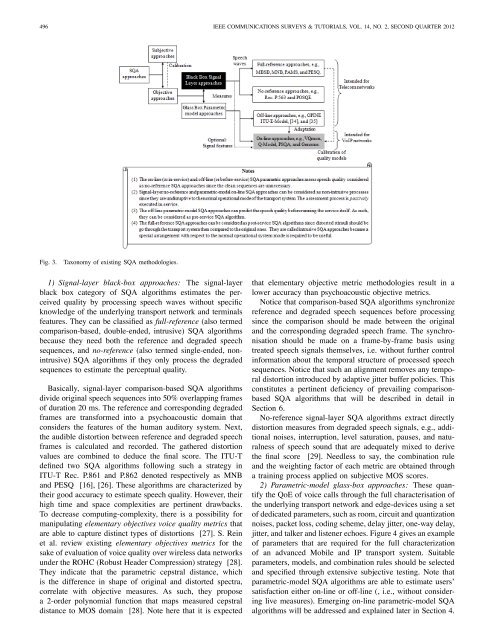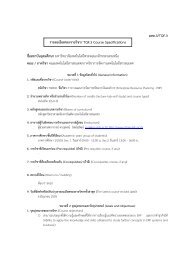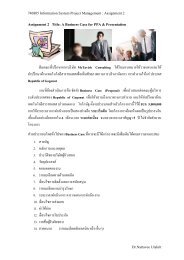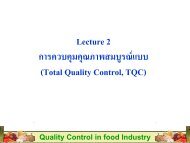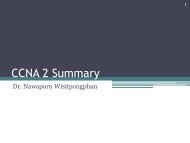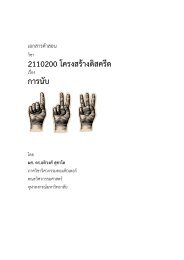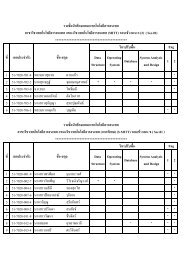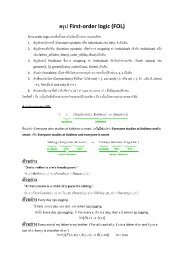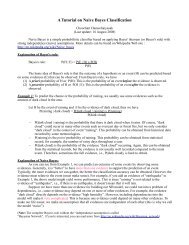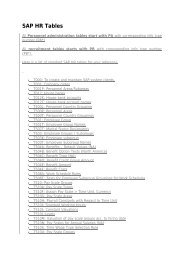496 <strong>IEEE</strong> COMMUNICATIONS SURVEYS & TUTORIALS, VOL. 14, NO. 2, SECOND QUARTER 2012Fig. 3.Taxonomy <strong>of</strong> existing SQA methodologies.1) Signal-layer black-box approaches: The signal-layerblack box category <strong>of</strong> SQA algorithms estimates the perceivedquality by processing speech waves without specificknowledge <strong>of</strong> the underlying transport network and terminalsfeatures. They can be classified as full-reference (also termedcomparison-based, double-ended, intrusive) SQA algorithmsbecause they need both the reference and degraded speechsequences, and no-reference (also termed single-ended, nonintrusive)SQA algorithms if they only process the degradedsequences to estimate the perceptual quality.Basically, signal-layer comparison-based SQA algorithmsdivide original speech sequences into 50% overlapping frames<strong>of</strong> duration 20 ms. The reference and corresponding degradedframes are transformed into a psychoacoustic domain thatconsiders the features <strong>of</strong> the human auditory system. Next,the audible distortion between reference and degraded speechframes is calculated and recorded. The gathered distortionvalues are combined to deduce the final score. The ITU-Tdefined two SQA algorithms following such a strategy inITU-T Rec. P.861 and P.862 denoted respectively as MNBand PESQ [16], [26]. These algorithms are characterized bytheir good accuracy to estimate speech quality. However, theirhigh time and space complexities are pertinent drawbacks.To decrease computing-complexity, there is a possibility formanipulating elementary objectives voice quality metrics thatare able to capture distinct types <strong>of</strong> distortions [27]. S. Reinet al. review existing elementary objectives metrics for thesake <strong>of</strong> evaluation <strong>of</strong> voice quality over wireless data networksunder the ROHC (Robust Header Compression) strategy [28].They indicate that the parametric cepstral distance, whichis the difference in shape <strong>of</strong> original and distorted spectra,correlate with objective measures. As such, they proposea 2-order polynomial function that maps measured cepstraldistance to MOS domain [28]. Note here that it is expectedthat elementary objective metric methodologies result in alower accuracy than psychoacoustic objective metrics.Notice that comparison-based SQA algorithms synchronizereference and degraded speech sequences before processingsince the comparison should be made between the originaland the corresponding degraded speech frame. The synchronisationshould be made on a frame-by-frame basis usingtreated speech signals themselves, i.e. without further controlinformation about the temporal structure <strong>of</strong> processed speechsequences. Notice that such an alignment removes any temporaldistortion introduced by adaptive jitter buffer policies. Thisconstitutes a pertinent deficiency <strong>of</strong> prevailing comparisonbasedSQA algorithms that will be described in detail inSection 6.No-reference signal-layer SQA algorithms extract directlydistortion measures from degraded speech signals, e.g., additionalnoises, interruption, level saturation, pauses, and naturalness<strong>of</strong> speech sound that are adequately mixed to derivethe final score [29]. Needless to say, the combination ruleand the weighting factor <strong>of</strong> each metric are obtained througha training process applied on subjective MOS scores.2) Parametric-model glass-box approaches: These quantifythe QoE <strong>of</strong> voice calls through the full characterisation <strong>of</strong>the underlying transport network and edge-devices using a set<strong>of</strong> dedicated parameters, such as room, circuit and quantizationnoises, packet loss, coding scheme, delay jitter, one-way delay,jitter, and talker and listener echoes. Figure 4 gives an example<strong>of</strong> parameters that are required for the full characterization<strong>of</strong> an advanced Mobile and IP transport system. Suitableparameters, models, and combination rules should be selectedand specified through extensive subjective testing. Note thatparametric-model SQA algorithms are able to estimate users’satisfaction either on-line or <strong>of</strong>f-line (, i.e., without consideringlive measures). Emerging on-line parametric-model SQAalgorithms will be addressed and explained later in Section 4.
JELASSI et al.: QUALITY OF EXPERIENCE OF VOIP SERVICE: A SURVEY OF ASSESSMENT APPROACHES AND OPEN ISSUES 497Fig. 4. Perceptual QoS factors affecting the perceived quality <strong>of</strong> advancedmobile and IP-based communication [31].A well-known <strong>of</strong>f-line parametric-model computationalSQA algorithm, named E-Model, has been defined by the ITU-T in Rec. G.107. The E-Model predicts users’ satisfactionunder a given planned transport configuration [30]. Theprevailing version <strong>of</strong> ITU-T E-Model has 21 input parametersthat tightly characterize the designed configurations.The output <strong>of</strong> the ITU-T E-Model is a single scalar valuereferred to as rating factor R that lies between 0 (Worst<strong>Quality</strong>) and 100 (Excellent <strong>Quality</strong>). In practice, a designedtransport configuration which results in a rating factor belowthan 60 should be avoided. In such a case, suitable remediesshould be undertaken to improve users’ satisfaction. Theindividual sources <strong>of</strong> quality degradation are classified intothree primary impairment factors, which will be detailed inSection 4.1. ITU-T Rec. G.107 provides the range values <strong>of</strong>each individual parameter and the combination models thatenable computing the value <strong>of</strong> each primary impairment factor.The final rating score is calculated through the key assumptionthat the perceived effects <strong>of</strong> primary impairment factors areadditive on a psychological scale.The E-Model has many limitations, especially in the context<strong>of</strong> many <strong>VoIP</strong> transport systems that need to be understoodto avoid misuse. Within the E-Model, input parameters areconstant during a voice session, which is inconsistent with thefeatures <strong>of</strong> time-varying QoS transport networks. Moreover,it has been subjectively shown that applying an additiveeffect <strong>of</strong> primary impairment factors on psychological scaleentails a significant inaccuracy <strong>of</strong> users’ satisfaction. Moreover,ITU-T E-Model is speech-independent. This explainswhy the utilisation <strong>of</strong> ITU-T E-Model should be confinedto planning purposes as defined by the ITU-T. In [32],the author developed more sophisticated combination rules <strong>of</strong>primary impairment factors to more accurately reflect userssatisfaction. Moreover, a combination <strong>of</strong> E-Model and PESQ 3(Perceptual Evaluation <strong>of</strong> Speech <strong>Quality</strong>) has been proposedto subsume the features <strong>of</strong> delivered speech waves [33].The ITU-T E-Model is currently under significant revisions toaccount for the evolving features <strong>of</strong> IP-based NGN, such aswideband speech coding schemes, adaptive behavior <strong>of</strong> <strong>VoIP</strong>application, and specific features <strong>of</strong> each language [34], [35].Notice that recently there is the emerging <strong>of</strong> the concept <strong>of</strong>partial-reference parametric SQA algorithms that quantify theQoE using network measurable parameters and metadata char-3 PESQ is a full-reference signal-layer speech quality assessment algorithmdescribed in ITU-T Rec. P.862.acterizing the original structure <strong>of</strong> reference speech sequence,such as the perceptual importance <strong>of</strong> sent voice frames andoperational mode <strong>of</strong> voice activity detector [36], [37].It is worth to note here that the selection <strong>of</strong> suitableSQA algorithms depends on the intended goals and themeasurement context [31]. Intrusive double-ended signallayerSQA algorithms are suitable for onsite diagnosis andtuning <strong>of</strong> terminals and networks. Off-line parametric-modelSQA algorithms are suitable for planning purposes, i.e., duringthe design <strong>of</strong> communication systems. On-line parametricmodelsand signal-layer single-ended SQA algorithms aresuitable for quality monitoring, billing, and service management.Typically, telecom operators with a R&D (Research &Development) division, such as Ericsson, Deutsch Telekomand British Telecom, develop their propriety implementations<strong>of</strong> previously described SQA algorithms and their companions<strong>of</strong>tware tools for measures’ acquisition, recording, and analysisthat satisfy their specific needs. However, the majority <strong>of</strong>telecom operators and voice service providers delegate the task<strong>of</strong> assessment <strong>of</strong> their transport infrastructure, services, andequipments to specialized corporations, such as GL, OPTI-COM, Telchemy, and HEAD Acoustics. They are responsiblefor the evaluation, the detection <strong>of</strong> anomaly, and the proposal<strong>of</strong> efficient remedies for improving the perceived quality overthe tested transport systems and services.In the context <strong>of</strong> <strong>VoIP</strong>, online parametric-model singleendedSQA approaches (Grey Box in Figure 3) are moresuitable because <strong>of</strong> their reduced overhead and their abilityto manage and monitor live <strong>VoIP</strong> sessions delivered throughheterogeneous transport infrastructures. In such a case, themeasure <strong>of</strong> speech quality is performed through the monitoring<strong>of</strong> the flow <strong>of</strong> voice packets without any access to speechsignals which is preferable for privacy reasons. However,generally speaking, parametric-model SQA algorithms arerelatively less accurate than signal-layer SQA algorithms.Notice that signal-layer SQA algorithms have been extensivelystudied in the literature since early days <strong>of</strong> telecom networks[16]. This explains why this paper solely details new emergingsingle-ended parametric-model SQA algorithms <strong>of</strong> <strong>VoIP</strong> service,which are well-suited to accommodate stakeholder needs.III. UTILIZATION METHODOLOGIES AND OUTPUTS OFOBJECTIVE SQA ALGORITHMSIn this section, we enumerate different deployment andexploitation methodologies <strong>of</strong> objective SQA algorithms. Intheir early days, objective SQA approaches were implementedusing C-like languages, which needed expert people to manipulatethem. During the last decade, new speech qualityassessment frameworks have evolved, which are equippedwith user-friendly interfaces. For instance, GL 4 Corporationhas developed proprietary s<strong>of</strong>tware called VQuad, which isan easy-to-use assessment platform <strong>of</strong> speech signals deliveredover a wide range <strong>of</strong> heterogeneous networks, namely,TDM, <strong>VoIP</strong>, and wireless networks. VQuad enables automatictesting / simulating <strong>of</strong> PSTN and <strong>VoIP</strong> phones. Moreover,VQuad facilitates assessment <strong>of</strong> existing or planned mobileradio systems and wireless phones attached through various4 www.gl.com


